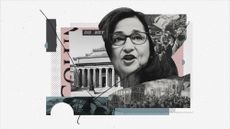Best Columns
Issue of the week: Taking stock of the 1987 crash
Issue of the week: Taking stock of the 1987 crash
Even veteran stock traders had never seen a day like Monday, Oct. 19, 1987, said Leslie A. Pappas in the Wilmington, Del., News Journal. On that fateful day, the Dow Jones industrial average took its biggest one-day fall since 1929, plunging a “stomachchurning” 23 percent—508 points—in a single, chaotic session. As investors this week mark the 20th anniversary of Black Monday, many “are remembering the crash—and wondering whether it could happen again.” The parallels between 1987 and today are certainly unsettling, said Michael Kahn in Marketwatch.com. Then as now, a “rookie” Federal Reserve chairman—then Alan Greenspan, today Ben Bernanke—was facing his first financial crisis. The stock market was surging, but the dollar was falling. “A two-term Republican president was winding down his tenure,” and the U.S. was burdened with a major trade imbalance with an Asian economic powerhouse— Japan then, China now. These parallels are eerie enough, said Conrad de Aenlle in The New York Times, but another similarity is downright frightening. Just as in 1987, a herd mentality has taken over investment managers. Back then, they boasted that computerdriven “portfolio insurance” would protect them from a steep plunge in stock prices. Perversely, though, the computers “compelled investors to intensify their selling of stocks the more the market declined,” accelerating the rout. A similar dynamic occurred in the debt markets this past summer, when many hedge fund managers embraced a single, disastrous strategy: They piled into mortgage securities, pushing their prices higher and higher. Once prices began to fall, they all tried to sell at once, causing the market to seize up. “I’d like to say that we’re much more sophisticated,” said Henry Herrmann of the mutual fund house Waddell & Reed, “and that this makes a crash less likely. I’d like to say it, but it’s not true.” Everyone can calm down, said Andrew Bary in Baron’s. The differences between 1987 and 2007 are far more significant than the similarities. For one thing, investors have “come to expect” that when the market suffers a sudden shock, as it did during the summer’s subprime mortgage crisis, the Fed will lower short-term interest rates, easing market fears. Equally important, stocks are far more reasonably priced than they were in 1987, when their prices were considerably higher than their intrinsic value. Today, said Bank of America trading strategist Tom McManus, “stocks have a much more stable foundation of valuation.” We mustn’t get too complacent, though, said Ben Steverman in BusinessWeek. “To this day, no one knows for sure why the markets chose Oct. 19 to crash.” All that’s known for certain is that “the mood on Wall Street shifted suddenly, and everyone tried to sell stocks at once.” Wall Street is just as susceptible to sudden mood swings today. True, investors have more solid data on the markets and the economy than they did then, and most stock exchanges now order trading halts when prices fall too rapidly. But even with those safeguards in place, “financial panics may never go away.” They’re just part of “our collective human nature.”
The case against tougher sanctions on Myanmar
Subscribe to The Week
Escape your echo chamber. Get the facts behind the news, plus analysis from multiple perspectives.

Sign up for The Week's Free Newsletters
From our morning news briefing to a weekly Good News Newsletter, get the best of The Week delivered directly to your inbox.
From our morning news briefing to a weekly Good News Newsletter, get the best of The Week delivered directly to your inbox.
Matthew Swibel and Soyoung Ho
Forbes
Washington has sanctions fever again, said Matthew Swibel and Soyoung Ho in Forbes. As Myanmar’s military rulers crack down on dissenters, politicians from both parties are urging the U.S. to tighten economic sanctions on the regime. But a study from the Peterson Institute for International Economics, a Washington think tank, finds that “unilateral efforts to choke off investment, trade, and the like work in maybe one in five cases.” More often, sanctions “end up hurting innocent people, rallying support for dictators,” and encouraging corruption. What might actually help people in Myanmar, believe it or not, is “a stronger corporate presence.” Chevron, which is a partner in Myanmar’s natural-gas pipeline, funds nonprofit organizations there that have “helped reduce cases of malaria, AIDS, and child mortality.” It has also built hospitals and “floated small loans to pig farmers, construction firms, and other businesses.” If Chevron and other Western corporations pulled out of Myanmar, says the Peterson Institute’s Gary Hufbauer, the country “would regress still faster into the Middle Ages.” Is that what sanctions supporters really want?
The picture of health? Not this economy
Sign up for Today's Best Articles in your inbox
A free daily email with the biggest news stories of the day – and the best features from TheWeek.com
Robert Shiller
The New York Times
“A recession has much the same pattern as the flu,” said economist Robert Shiller in The New York Times. Both start “with vague feelings of malaise” and run rapidly downhill from there. The U.S. economy now appears to have a case of the sniffles, as evidenced by the unemployment rate’s rise from 4.4 percent in March to 4.7 percent in September. Will that cold turn into the flu? A look at the patient’s medical history suggests it might. During the months leading up to the 1990 recession, “we were coming out of a housing boom and the economy was emerging from an associated lending crisis.” Sound familiar? But the recession didn’t really kick in until Saddam Hussein invaded Kuwait in August 1990, prompting business travelers to cancel trips and sparking “an intense public conversation” about the health of the economy. These “salient, emotion- arousing narratives” are a crucial element in recessions because they lead people to change their spending habits. Today, the housing crisis and the credit crunch have people talking about “foreclosures and failures of financial institutions.” If that downbeat conversation continues, the economy’s aches and pains may well turn into full-blown flu.
Create an account with the same email registered to your subscription to unlock access.
-
 Cicada-geddon: the fungus that controls insects like 'zombies'
Cicada-geddon: the fungus that controls insects like 'zombies'Under The Radar Expert says bugs will develop 'hypersexualisation' despite their genitals falling off
By Chas Newkey-Burden, The Week UK Published
-
 'Voters know Biden and Trump all too well'
'Voters know Biden and Trump all too well'Instant Opinion Opinion, comment and editorials of the day
By Harold Maass, The Week US Published
-
 Is the Gaza war tearing US university campuses apart?
Is the Gaza war tearing US university campuses apart?Today's Big Question Protests at Columbia University, other institutions, pit free speech against student safety
By Joel Mathis, The Week US Published
-
Issue of the week: Yahoo’s ban on working from home
feature There’s a “painful irony” in Yahoo’s decision to make all its employees come to the office to work.
By The Week Staff Last updated
-
Issue of the week: Another big airline merger
feature The merger of American Airlines and US Airways will be the fourth between major U.S. airlines in five years.
By The Week Staff Last updated
-
Issue of the week: Feds’ fraud suit against S&P
feature The Justice Department charged S&P with defrauding investors by issuing mortgage security ratings it knew to be misleading.
By The Week Staff Last updated
-
Issue of the week: Why investors are worried about Apple
feature Some investors worry that the company lacks the “passion and innovation that made it so extraordinary for so long.”
By The Week Staff Last updated
-
Issue of the week: Does Google play fair?
feature The Federal Trade Commission cleared Google of accusations that it skews search results to its favor.
By The Week Staff Last updated
-
Issue of the week: The Fed targets unemployment
feature By making public its desire to lower unemployment, the Fed hopes to inspire investors “to behave in ways that help bring that about.”
By The Week Staff Last updated
-
Issue of the week: Is Apple coming home?
feature Apple's CEO said the company would spend $100 million next year to produce a Mac model in the U.S.
By The Week Staff Last updated
-
Issue of the week: Gunning for a hedge fund mogul
feature The feds are finally closing in on legendary hedge fund boss Steven Cohen.
By The Week Staff Last updated